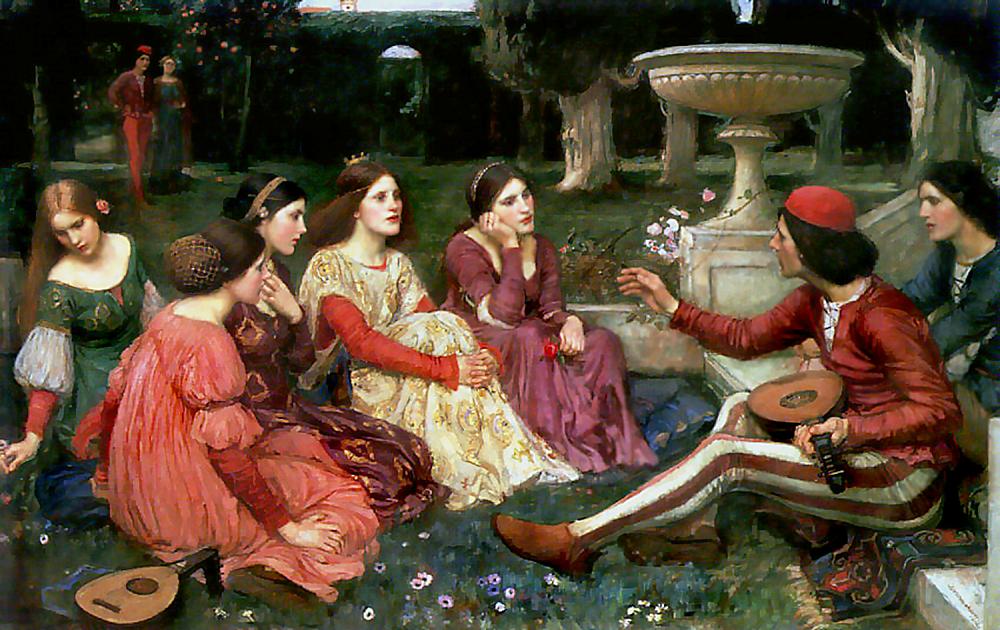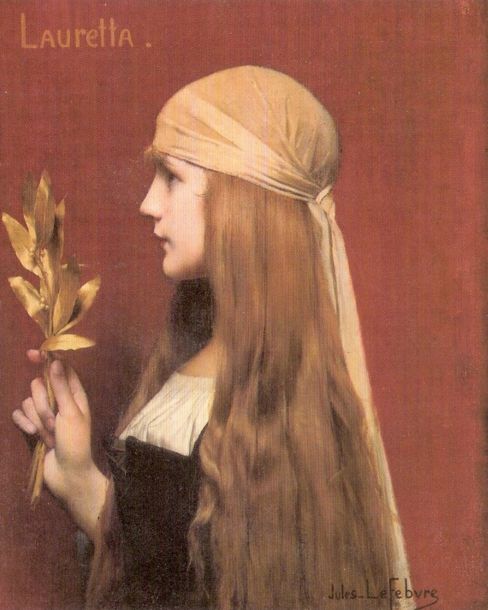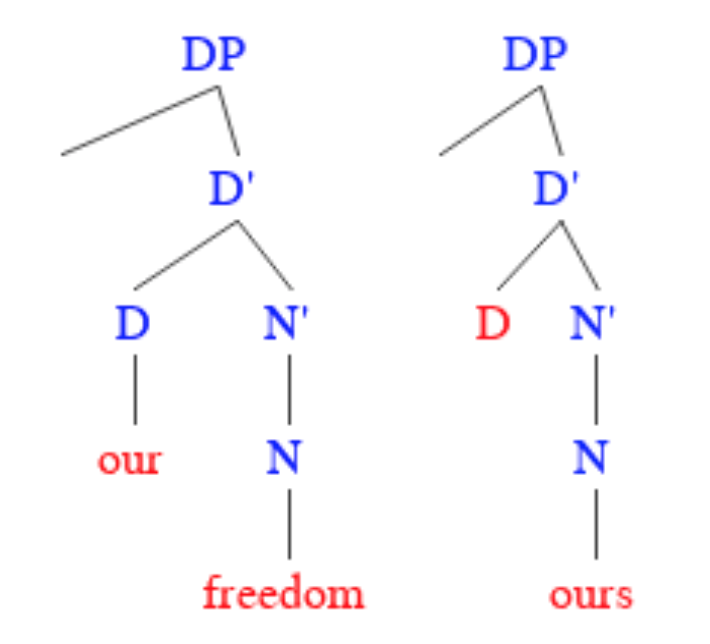|
The Shipman's Tale
"The Shipman's Tale" (also called ''The Sailor's Tale'') is one of ''The Canterbury Tales'' by Geoffrey Chaucer. It is in the form of a fabliau and tells the story of a merchant, his wife and her lover, a monk. Although similar stories can be found in Boccaccio's '' Decameron'', a frequent source for Chaucer's tales, the story is a retelling of a common type of folktale called "the lover's gift regained". Plot The tale tells of a merchant whose wife enjoys revelry and socializing, on which she spends money. A young monk, who is close friends with the merchant, comes to stay with them. After confessing that she does not love her husband, the wife asks the monk for one hundred franks to pay her debts. The monk, without her knowledge, borrows the money from the merchant to give to the wife, at which point she agrees with the monk: :"That for thise hundred frankes he sholde al nyght :Have hire in his armes bolt upright;" (lines 315–316) The monk volunteers the information t ... [...More Info...] [...Related Items...] OR: [Wikipedia] [Google] [Baidu] |
The Shipman - Ellesmere Chaucer
''The'' () is a grammatical article in English, denoting persons or things that are already or about to be mentioned, under discussion, implied or otherwise presumed familiar to listeners, readers, or speakers. It is the definite article in English. ''The'' is the most frequently used word in the English language; studies and analyses of texts have found it to account for seven percent of all printed English-language words. It is derived from gendered articles in Old English which combined in Middle English and now has a single form used with nouns of any gender. The word can be used with both singular and plural nouns, and with a noun that starts with any letter. This is different from many other languages, which have different forms of the definite article for different genders or numbers. Pronunciation In most dialects, "the" is pronounced as (with the voiced dental fricative followed by a schwa) when followed by a consonant sound, and as (homophone of the archai ... [...More Info...] [...Related Items...] OR: [Wikipedia] [Google] [Baidu] |
The Canterbury Tales
''The Canterbury Tales'' ( enm, Tales of Caunterbury) is a collection of twenty-four stories that runs to over 17,000 lines written in Middle English by Geoffrey Chaucer between 1387 and 1400. It is widely regarded as Chaucer's ''magnum opus''. The tales (mostly written in verse, although some are in prose) are presented as part of a story-telling contest by a group of pilgrims as they travel together from London to Canterbury to visit the shrine of Saint Thomas Becket at Canterbury Cathedral. The prize for this contest is a free meal at the Tabard Inn at Southwark on their return. It has been suggested that the greatest contribution of ''The Canterbury Tales'' to English literature was the popularisation of the English vernacular in mainstream literature, as opposed to French, Italian or Latin. English had, however, been used as a literary language centuries before Chaucer's time, and several of Chaucer's contemporaries—John Gower, William Langland, the Pearl Poet, and Jul ... [...More Info...] [...Related Items...] OR: [Wikipedia] [Google] [Baidu] |
Geoffrey Chaucer
Geoffrey Chaucer (; – 25 October 1400) was an English poet, author, and civil servant best known for ''The Canterbury Tales''. He has been called the "father of English literature", or, alternatively, the "father of English poetry". He was the first writer to be buried in what has since come to be called Poets' Corner, in Westminster Abbey. Chaucer also gained fame as a philosopher and astronomer, composing the scientific '' A Treatise on the Astrolabe'' for his 10-year-old son Lewis. He maintained a career in the civil service as a bureaucrat, courtier, diplomat, and member of parliament. Among Chaucer's many other works are '' The Book of the Duchess'', '' The House of Fame'', '' The Legend of Good Women'', and '' Troilus and Criseyde''. He is seen as crucial in legitimising the literary use of Middle English when the dominant literary languages in England were still Anglo-Norman French and Latin. Chaucer's contemporary Thomas Hoccleve hailed him as "the firste fy ... [...More Info...] [...Related Items...] OR: [Wikipedia] [Google] [Baidu] |
Fabliau
A ''fabliau'' (; plural ''fabliaux'') is a comic, often anonymous tale written by jongleurs in northeast France between c. 1150 and 1400. They are generally characterized by sexual and scatological obscenity, and by a set of contrary attitudes—contrary to the church and to the nobility. Several of them were reworked by Giovanni Boccaccio for the '' Decameron'' and by Geoffrey Chaucer for his '' Canterbury Tales''. Some 150 French ''fabliaux'' are extant, the number depending on how narrowly ''fabliau'' is defined. According to R. Howard Bloch, ''fabliaux'' are the first expression of literary realism in Europe. Some nineteenth-century scholars, most notably Gaston Paris, argue that ''fabliaux'' originally came from the Orient and were brought to the West by returning crusaders. History and definition of the genre The ''fabliau'' is defined as a short narrative in (usually octosyllabic) verse, between 300 and 400 lines long,Cuddon 301. its content often comic or satiric.A ... [...More Info...] [...Related Items...] OR: [Wikipedia] [Google] [Baidu] |
Monk
A monk (, from el, μοναχός, ''monachos'', "single, solitary" via Latin ) is a person who practices religious asceticism by monastic living, either alone or with any number of other monks. A monk may be a person who decides to dedicate their life to serving other people and serving God, or to be an ascetic who voluntarily chooses to leave mainstream society and live their life in prayer and contemplation. The concept is ancient and can be seen in many religions and in philosophy. In the Greek language, the term can apply to women, but in modern English it is mainly in use for men. The word '' nun'' is typically used for female monastics. Although the term ''monachos'' is of Christian origin, in the English language ''monk'' tends to be used loosely also for both male and female ascetics from other religious or philosophical backgrounds. However, being generic, it is not interchangeable with terms that denote particular kinds of monk, such as cenobite, hermit, anc ... [...More Info...] [...Related Items...] OR: [Wikipedia] [Google] [Baidu] |
Boccaccio
Giovanni Boccaccio (, , ; 16 June 1313 – 21 December 1375) was an Italian writer, poet, correspondent of Petrarch, and an important Renaissance humanist. Born in the town of Certaldo, he became so well known as a writer that he was sometimes simply known as "the Certaldese" and one of the most important figures in the European literary panorama of the fourteenth century. Some scholars (including Vittore Branca) define him as the greatest European prose writer of his time, a versatile writer who amalgamated different literary trends and genres, making them converge in original works, thanks to a creative activity exercised under the banner of experimentalism. His most notable works are '' The Decameron'', a collection of short stories which in the following centuries was a determining element for the Italian literary tradition, especially after Pietro Bembo elevated the Boccaccian style to a model of Italian prose in the sixteenth century, and '' On Famous Women''. He w ... [...More Info...] [...Related Items...] OR: [Wikipedia] [Google] [Baidu] |
The Decameron
''The Decameron'' (; it, label= Italian, Decameron or ''Decamerone'' ), subtitled ''Prince Galehaut'' (Old it, Prencipe Galeotto, links=no ) and sometimes nicknamed ''l'Umana commedia'' ("the Human comedy", as it was Boccaccio that dubbed Dante Alighieri's ''Comedy'' "''Divine''"), is a collection of short stories by the 14th-century Italian author Giovanni Boccaccio (1313–1375). The book is structured as a frame story containing 100 tales told by a group of seven young women and three young men; they shelter in a secluded villa just outside Florence in order to escape the Black Death, which was afflicting the city. Boccaccio probably conceived of the ''Decameron'' after the epidemic of 1348, and completed it by 1353. The various tales of love in ''The Decameron'' range from the erotic to the tragic. Tales of wit, practical jokes, and life lessons contribute to the mosaic. In addition to its literary value and widespread influence (for example on Chaucer's '' Canterbury Ta ... [...More Info...] [...Related Items...] OR: [Wikipedia] [Google] [Baidu] |
Folklore
Folklore is shared by a particular group of people; it encompasses the traditions common to that culture, subculture or group. This includes oral traditions such as Narrative, tales, legends, proverbs and jokes. They include material culture, ranging from traditional building styles common to the group. Folklore also includes Tradition, customary lore, taking actions for folk beliefs, the forms and rituals of celebrations such as Christmas and weddings, folk dances and Rite of passage, initiation rites. Each one of these, either singly or in combination, is considered a Cultural artifact, folklore artifact or Cultural expressions, traditional cultural expression. Just as essential as the form, folklore also encompasses the transmission of these artifacts from one region to another or from one generation to the next. Folklore is not something one can typically gain in a formal school curriculum or study in the fine arts. Instead, these traditions are passed along informally from o ... [...More Info...] [...Related Items...] OR: [Wikipedia] [Google] [Baidu] |
Pronoun
In linguistics and grammar, a pronoun ( abbreviated ) is a word or a group of words that one may substitute for a noun or noun phrase. Pronouns have traditionally been regarded as one of the parts of speech, but some modern theorists would not consider them to form a single class, in view of the variety of functions they perform cross-linguistically. An example of a pronoun is "you", which can be either singular or plural. Subtypes include personal and possessive pronouns, reflexive and reciprocal pronouns, demonstrative pronouns, relative and interrogative pronouns, and indefinite pronouns. The use of pronouns often involves anaphora, where the meaning of the pronoun is dependent on an antecedent. For example, in the sentence ''That poor man looks as if he needs a new coat'', the meaning of the pronoun ''he'' is dependent on its antecedent, ''that poor man''. The name of the adjective that belongs with a "pronoun" is called a "pronominal". A pronominal is also a word o ... [...More Info...] [...Related Items...] OR: [Wikipedia] [Google] [Baidu] |
The Wife Of Bath's Prologue And Tale
"The Wife of Bath's Tale" ( enm, The Tale of the Wyf of Bathe) is among the best-known of Geoffrey Chaucer's ''Canterbury Tales''. It provides insight into the role of women in the Late Middle Ages and was probably of interest to Chaucer himself, for the character is one of his most developed ones, with her Prologue twice as long as her Tale. He also goes so far as to describe two sets of clothing for her in his General Prologue. She holds her own among the bickering pilgrims, and evidence in the manuscripts suggests that although she was first assigned a different, plainer tale—perhaps the one told by the Shipman—she received her present tale as her significance increased. She calls herself both Alyson and Alys in the prologue, but to confuse matters these are also the names of her 'gossib' (a close friend or gossip), whom she mentions several times, as well as many female characters throughout ''The Canterbury Tales''. Geoffrey Chaucer wrote the "Prologue of the Wife of ... [...More Info...] [...Related Items...] OR: [Wikipedia] [Google] [Baidu] |
The Man Of Law's Tale
"The Man of Law's Tale" is the fifth of the '' Canterbury Tales'' by Geoffrey Chaucer, written around 1387. John Gower's "Tale of Constance" in '' Confessio Amantis'' tells the same story and may have been a source for Chaucer. Nicholas Trivet's ''Les chronicles'' was a source for both authors. Wurtele provides a detailed compilation of the differences between Trivet's Chronicle and the poems of Gower and Chaucer. Gower strove for vividness and shortened the tale in places. Chaucer expanded the tale and emphasizes the holiness of Constance and how she was favoured by heaven. Hagiographic motifs are most abundant in Chaucer's version, e.g. “the miracles God works though Custance and the way she is miraculously fed while at sea”. 2Wurtele observes that Chaucer makes frequent use of the adjective "hooly" but Gower never uses this word. Synopsis (References here are to line numbers in both Man of Law's Tale (MLT) and Confessio Amantis (CA).) Constance (Custance in Chaucer) ... [...More Info...] [...Related Items...] OR: [Wikipedia] [Google] [Baidu] |
Dartmouth, Devon
Dartmouth () is a town and civil parish in the English county of Devon. It is a tourist destination set on the western bank of the estuary of the River Dart, which is a long narrow tidal ria that runs inland as far as Totnes. It lies within the South Devon Area of Outstanding Natural Beauty and South Hams district, and had a population of 5,512 in 2001, reducing to 5,064 at the 2011 census. There are two electoral wards in the ''Dartmouth'' area ( Townstal & Kingswear). Their combined population at the above census was 6,822. History In 1086, the Domesday Book listed ''Dunestal'' as the only settlement in the area which now makes up the parish of Dartmouth. It was held by Walter of Douai. It paid tax on half a hide, and had two plough teams, two slaves, five villagers and four smallholders. There were six cattle, 40 sheep and 15 goats. At this time Townstal (as the name became) was apparently a purely agricultural settlement, centred around the church. Walter of Dou ... [...More Info...] [...Related Items...] OR: [Wikipedia] [Google] [Baidu] |

.png)


_School_-_Boccaccio_(1313–1375)_(Giovanni_Boccaccio)_-_355512_-_National_Trust.jpg)



.jpg)
